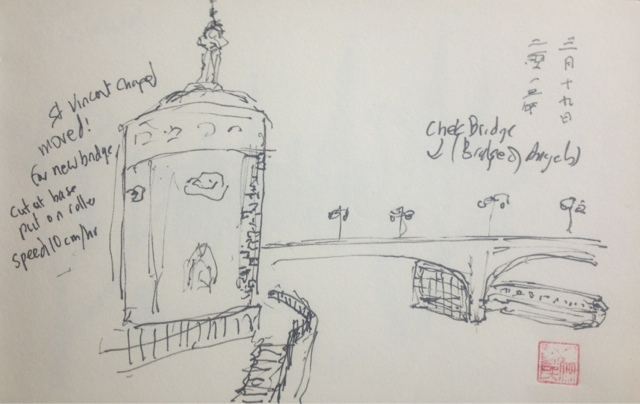We stayed at this hotel: value for money
On tour through Prague: around old town square:
the Powder House dating back to 1600's:
Municipal Building
As annotated:
In the middle, behind: the place where Mozart's Don Giovanni was first performed.
Also of note, many historic rooms were now 3-7 metres below current road level
Recurrent flooding of Prague had caused them to raise the road level repeatedly through the centuries.
The astronomic clock and St Nicholas Church at Old town Square
Tower bears three styles of clock systems: Babylonian, Old Czeck timescale and modern
The twelve apostles and 4 articulated figures (Jew [Money], Turk [Infidel], Vanity & Death) appear every hour on the hour as the clock chimes
Iconic Church of Tyn
This chapel stood in the way of Čech Most (Cech Bridge) and was moved.
The sun was shining in my eyes so I could barely see more than a silhouette of St Vitus Cathedral (Prague Castle) from this angle: None the less I think it made a successful sketch.
View from first (outer) courtyard
View of Third Courtyard
Back of napkin sketch at breakfast time
Church of Tyn, more leisurely 20 minute sketch
Performance at Secondary School of Public Administration Prague.
At cultural hall
This poor lass was taken ill and unable to sing: Yet she watched and listened with rapt attention through the window as her choir sang in the church sanctuary 20 metre below.
The Church of the Holy Saviour (U Salvátora), Prague’s largest evangelic church devoted to the Holy Saviour (Salvator = Saviour). In the beginning of the 17th century, a great number of German Lutherans came to live in Prague, and soon they started to miss their own large church. The land plot for building one was purchased on their behalf by count Jáchym Ondřej Šlik by a house that later became the Paulan convent. In the years 1611 - 1614, they built a Gothic-Renaissance church of the Holy Saviour. J. Christofen of Graubünden was the builder; Giovanni Maria Filippi is assumed to have been the author of the project. After the Battle of Bílá Hora, the church was confiscated from the evangelics, it was closed and the preachers were expelled from Prague. In 1626, it was handed over the Paulan Order via a deed of donation, and this order modified the neighbouring house to a temporary monastery. Later on, they wanted to extend the monastery, and so they purchased the neighbouring house at the Old Town Square. The Paulan monastery was connected with the church via a covered corridor. The church burnt down in 1689 and after that, it was partially modified in Baroque style, with platform built above the side aisles. In 1720, a prismatic tower was added, and in the mid-18th century, the main aisle and the chancel were decorated by Rococo stuccoes. It was probably on this occasion that the church front was completed with two towers. Later building modifications of the church and of the convent in 1777 were conducted by the builder Jan Prachner. After the Josephinian reforms in 1784, the abolished monastery and the desecrated church were allotted to the mint office. In 1863, the church was purchased by Bohemian evangelics; it was restored to serve the divine purposes again, and consecrated. This state has remained unchanged until the present days.
Performing at Salvatora
Dinner at Chinese Resteraunt (Taiwan Eating House) The art motifs came from three of the paintings on the wall.
Performing at Cultural Hall
Royal mums (and grandma) box office view:
This is the outside view of cultural hall

another interpretation
Lunch at Dacicky:
Mirror maze at Petrine Hill
One of my favourite sketches! Captured the essence of the Black Light Theatre
Very pleased to sketch the residence of Mr Golem!
The Dial of the clock on the Jewish Town Hall has Hebrew Numerals and the clock runs anticlockwise!
I found this place awe inspiring: No photography did not mean no sketching!
Ended with a nice note
Lunch at Michals restraunt
Had 3 and a half cups of expresso!






























No comments:
Post a Comment